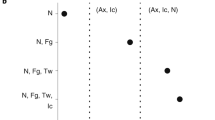Abstract
Although Acinetobacter is usually a species of low virulence, it is becoming increasingly more important as a cause of hospital outbreaks, particularly on intensive care units. Antibiotic resistance can develop rapidly. This organism has not been reported to cause skin abscesses previously. We describe a case of a neonate who developed an Acinetobacter abscess on our neonatal intensive care unit.
This is a preview of subscription content, access via your institution
Access options
Subscribe to this journal
Receive 12 print issues and online access
$259.00 per year
only $21.58 per issue
Buy this article
- Purchase on Springer Link
- Instant access to full article PDF
Prices may be subject to local taxes which are calculated during checkout
Similar content being viewed by others
References
Allen D M, Hartman B J . Acinetobacter species. In: Mandell G L, Bennett J E, Dolin R, editors. Principles and Practice of Infectious Diseases. 5th ed. Philadelphia: Churchill Livingston; 2000. p. 2339–2342.
Soultanis K, Mantelos G, Pagiatakis A, Soucacos P N . Late infection in patients with scoliosis treated with spinal instrumentation. Clin Orthop 2003;411:116–123.
Villegas M V, Hartstein A I . Acinetobacter outbreaks, 1977–2000. Infect Control Hosp Epidemiol 2003;24:284–295.
Niederman M S . Impact of antibiotic resistance on clinical outcomes and the cost of care. Crit Care Med 2001;29:N114–N120.
Seward RJ, Lambert T, Towner KJ . Molecular epidemiology of aminoglycoside resistance in Acinetobacter spp. J Med Microbiol 1998;47:455–462.
Glew RH, Moellering RC, Kunz LJ . Infections with Acinetobacter calcoaceticus. Clinical and laboratory studies. Medicine (Baltimore) 1977;56:79–97.
Jacobs A, Gros DA, Gradon JD . Thyroid abscess due to Acinetobacter calcoaceticus: case report and review of the causes and current management strategies for thyroid abscesses. South Med J 2003;96:300–307.
Mittal N, Nair D, Gupta N, et al. Outbreak of Acinetobacter spp septicaemia in a neonatal ICU. Southeast Asian J Trop Med Public Health 2003;34:365–366.
Petdachai W . Nosocomial pneumonia in a newborn intensive care unit. J Med Assoc Thai 2000;83:392–397.
Huang YC, Su LH, Wu TL, et al. Outbreak of Acinetobacter baumannii bacteremia in a neonatal intensive care unit: clinical implications and genotyping analysis. Pediatr Infect Dis J 2002;21:1105–1109.
Christo GG, Shenoy V, Matthai J, Shivananda PG, Venkatesh A . Acinetobacter sepsis in neonates. Indian Pediatr 1993;300:1413–1416.
Horrevorts A, Bregman K, Kollee L, Breuker I, Tjernberg I, Dijkshoorn L . Clinical and epidemiological investigations of Acinetobacter genomospecies 3 in a neonatal intensive care unit. J Clin Microbiol 1995;33:1567–1572.
Author information
Authors and Affiliations
Rights and permissions
About this article
Cite this article
Ng, G., Sharma, B. & Fox, G. Acinetobacter Skin Abscess in a Neonate. J Perinatol 24, 526–527 (2004). https://doi.org/10.1038/sj.jp.7211133
Published:
Issue Date:
DOI: https://doi.org/10.1038/sj.jp.7211133



